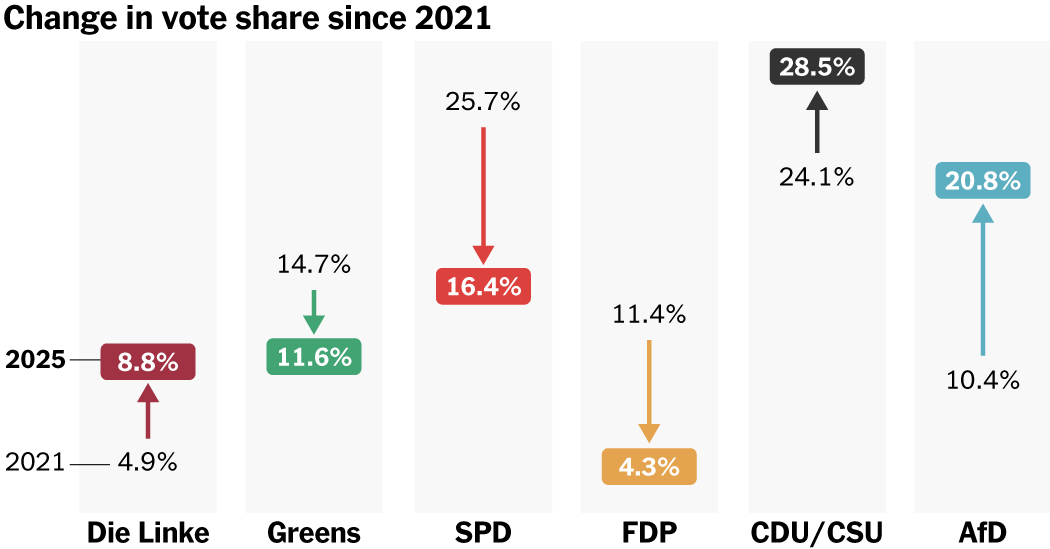How the 630 seats will be distributed
Germany’s conservative Christian Democrats (CDU/CSU) won Sunday’s election as voters rebuked the nation’s left-leaning government for its handling of the economy and immigration.
Provisional results by party
Party
Votes
Pct.
Seats
CDU/CSU
14,158,432
28.52
208
AfD
10,327,148
20.80
152
SPD
8,148,284
16.41
120
Greens
5,761,476
11.61
85
Die Linke
4,355,382
8.77
64
Others
2,273,817
4.58
1
BSW
2,468,670
4.97
0
FDP
2,148,878
4.33
0
Voters gave the far-right Alternative for Germany (AfD) party the second-highest number of seats in Parliament, ahead of Chancellor Olaf Scholz’s center-left Social Democrats (SPD) and the Greens, according to provisional results.
Change in vote share since 2021
The Christian Democrats, AfD and Die Linke won more votes than in the last general election.
There were smaller surprises, including the last-minute surge of the far-left party Die Linke. The liberal and pro-business Free Democrats (FDP), who had been a part of the last government until November, did not meet the 5 percent vote threshold they would need to maintain seats in Parliament. The Sahra Wagenknecht Alliance (BSW), a pro-Russia splinter from the old German left that formed last year, also fell just short of qualifying for parliamentary seats.
Highlighting the widespread discontent with Mr. Scholz’s government over the last three years, all three parties in the coalition — the Social Democrats, the Greens and FDP — lost support.
Vote shifts since 2021
Germans cast two votes when they go to the polls. The first vote goes to elect a direct representative for their district, while the second vote is cast for a party.
Arrows show the increase or decrease in each party’s vote share in the second vote, compared with the last general election.
Support for the Social Democrats plunged everywhere, but nowhere more than in the east. The Christian Democrats made gains throughout the southern and western districts.
The coalitions
The Christian Democrats will need to build a coalition to govern because they did not win an outright majority of seats. Given Sunday’s results, the most likely pairing is the CDU and the incumbent Social Democrats. That combination, known as a grand coalition, is historically stable and has been repeatedly tested, most recently during Angela Merkel’s final term as chancellor.
Mainstream two-party coalitions
CDU/CSU and SPD 328 total seats
CDU/CSU and Greens 293 total seats
Three party coalitions
SPD and Greens 205 total seats
CDU/CSU and Greens 293 total seats
CDU/CSU, SPD and Greens 413 total seats
Unlikely coalitions
CDU/CSU and AfD 360 total seats
316 seats needed
for majority
The largest possible coalition, the one between the Christian Democrats and AfD, is politically not an option, as mainstream parties have pledged not to work with the far-right party.
Checkout latest world news below links :
World News || Latest News || U.S. News
The post Germany Election Maps: How Conservatives Regained Power appeared first on WorldNewsEra.

